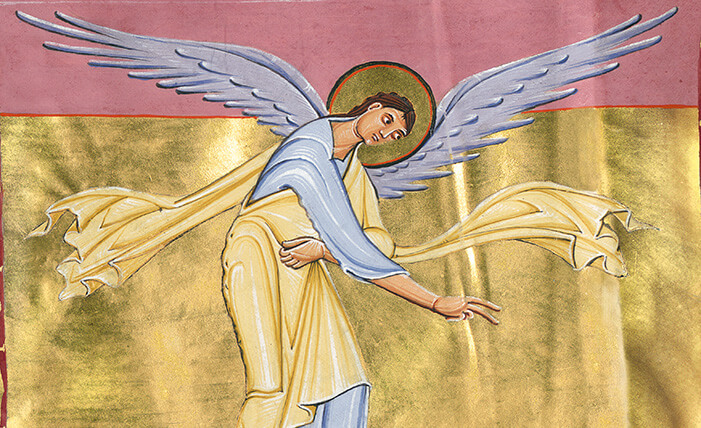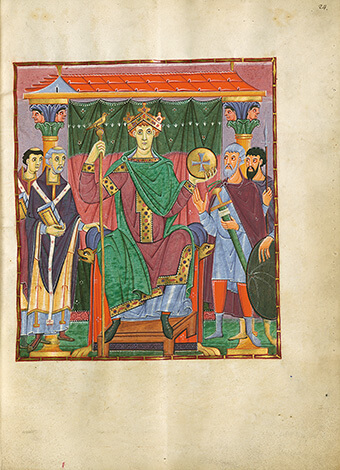Treasures of Reichenau Book Illumination
The Ottonian Manuscripts from the UNESCO Memory of the World Program
Vibrant colours made from precious pigments, the extensive use of highly burnished gold, stylized figure forms and an expressive art of painting brought to the highest perfection! Even today, the viewer is enthralled by the lavishly illuminated deluxe manuscripts which the monks on the island of Reichenau created for the Ottonian rulers as well as for important patrons of the Imperial court in the 10th and 11th century. It is evident that the illuminated manuscripts produced by the ‘Reichenau School’ during this period continue to fascinate people. Every page of these manuscripts evokes a solemn aura of the sublime and the sacred. In 2003, these magnificent creations inspired the UNESCO committee to inscribe ten of these works on the Memory of the World Register. The facsimile cassette published by Quaternio Editions Lucerne provides an insight into the wonderful imagery of these Ottonian masterpieces.
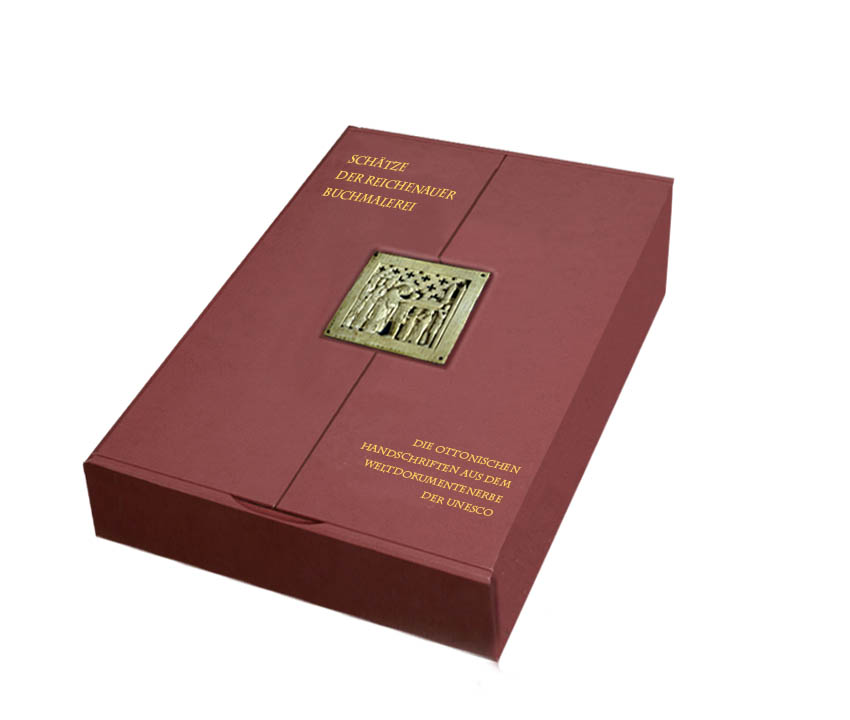
Treasures of Reichenau Book Illumination
Treasures of Reichenau Book Illumination: The edition
Added to the “Memory of the World”
Illuminated manuscripts made at Reichenau Abbey are among the most magnificent works of art created under the Ottonian emperors and kings (919-1024). At that time the Benedictine Abbey on the island of Reichenau in Lake Constance was one of the major cultural and scholarly centres of the East Frankish Empire. The scriptorium housed at Reichenau Abbey produced deluxe manuscripts of great beauty with an aesthetic that markedly influenced Ottonian art. In 2003 UNESCO added a set of ten manuscripts to the Memory of the World Register. Ten original facsimile folios displaying the most beautiful pictorial motifs from these masterpieces are presented by Quaternio Editions of Lucerne in this cassette edition.
Of Sublime Beauty
Symmetrical and flattened representations characterized by a solemn monumentality dominate the style of Ottonian book illumination. Most miniatures are full-page images. The artists applied a little shading to create spatial depth in their miniatures. The repertory of forms used in the illustrations is greatly reduced. Large, elongated and highly expressive figures command the narrative scenes with expansive and almost ecstatic gestures, thus unfolding a dynamic spirituality and an evocative power. The images are notable for the confident use of empty or monochrome spaces, consisting mostly of gold ground shining and shimmering as a reference to the unearthly sphere, reflecting the sublime beauty of the heavens.
The Reichenau School of Painting
The Abbey of Reichenau was founded in 724 by the Hiberno-Frankish itinerant Bishop Pirmin on an island in Lake Constance. Under Charlemagne the abbey ranked among the great Frankish imperial monasteries, while it gained even more influence under the Kings of the Ottonian dynasty. In particular, under the abbots Witigowo, Immo and Berno (985-1048), the scriptorium produced illuminated manuscripts of outstanding artistic quality, which were commissioned by emperors, kings and members of the higher clergy. At least 58 deluxe manuscripts from the ‘Reichenau School’ have survived. Only in seven of these works have the names of their scribes and illuminators been preserved.

Treasures of Reichenau Book Illumination
Under the Magnifying Glass: Ottonian Splendour and Magnificence
By providing generous patronage of dioceses and monasteries in the 10th and early 11th centuries, the Ottonian emperors and kings facilitated an intellectual and cultural flowering which gave rise to numerous important works of art. Ottonian art – also known as Pre-Romanesque art – is especially recognized in the illuminated manuscripts. Their pictorial program is notable for fusing the traditions of Late Antiquity and Byzantium. Ottonian monasteries and cathedral schools produced some magnificent manuscripts commissioned by emperors and kings, bishops, abbots and abbesses. The scriptoria of the great imperial monasteries such as the one at Reichenau were able to attract the best artists of their time. The masterpieces they produced were an important means of presenting and legitimizing their power.
The dedication miniture in the Gospel Book of Otto III. shows the youthful emperor depicted displaying the ideals associated with imperial authority. He is seated on a lion throne which is placed before an architectural structure with a richly decorated multi-coloured curtain. Consisting of a roof and two columns supported by acanthus capitals with heads, the structure represents a church, thus evoking the sacredness of the divinely appointed monarch. The emperor wears a purple mantle adorned with a gold border over a white undergarment, and a green cloak. He holds the insignia of his imperial power: the eagle on the scepter and the sphaira. He is flanked by important representatives of his empire: to his right stand two clerics of different ages clad as archbishops, while the two soldiers to his left are armed with a sword, a shield, and a lance.
Schätze der Reichenauer Buchmalerei
Treasures of Reichenau Book Illumination: The Cassette Edition
The Facsimile Cassette at a Glance
The facsimile cassette Treasures of Reichenau Book Illumination contains ten original facsimile folios from Ottonian deluxe manuscripts which were inscribed on the UNESCO Memory of the World Register in 2003.
10 Single folios from the following manuscripts: Bamberg, Staatsbibliothek, Msc.Bibl.22 (fol. 31v) und Msc.Bibl.140 (fol. 29v und 63v); München, Bayerische Staatsbibliothek, Clm 4453 (fol. 24r), Clm 4454 (fol. 25r) und Clm 4452 (fol. 8v); Trier, Stadtbibliothek, Hs. 24 (fol. 66r); Cividale del Friuli, Museo Archeologico Nazionale, Cod. 136 (fol. 20v); Paris, Bibliothèque nationale de France, Ms. lat. 10514 (fol. 3v), Aachen, Domschatzkammer, G 25 (fol. 16r)
Date of origin: between 970 and 1020
Place of origin: Reichenau Abbey
Dimensions of the single folios: height 23.8 – 42.5 cm, and width 18.5-32.0 cm
Size of the cassette: c. 44,0 x 33,0 cm
Artists: several monastic book illuminators
Patrons: Emperor Otto III, Emperor Henry II, Archbishop Egbert of Trier, and Bishop Bruno of Toul
Presentation: hand-made cassette in dark red with gold tooling, including the removable replica of a contemporary ivory panel as well as 10 original size, richly gilt facsimile folios, elegant bias cut passe-partouts for each folio
Brochure accompanying the edition by Esther-Luisa Schuster → Inhalt
Print run: 800 copies
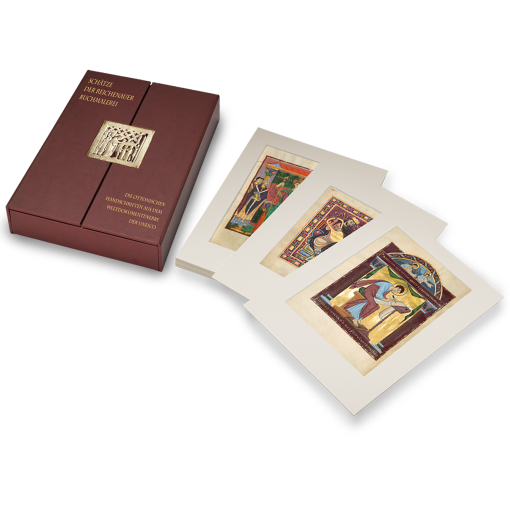
Treasures of Reichenau Book Illumination
A Challenging Production: fac simile
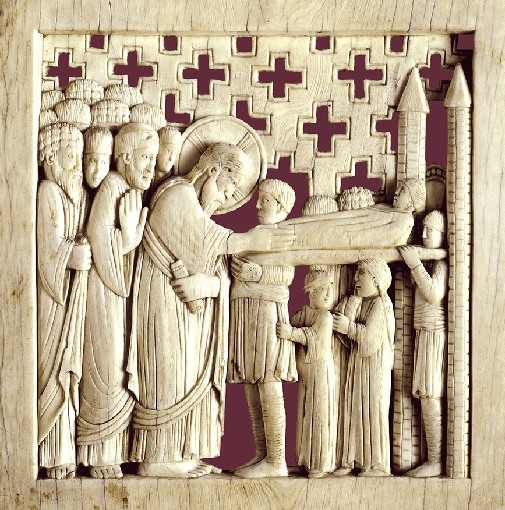
The Exact Replica of an Ivory Panel for Ornament
The hand-made facsimile cassette Treasures of Reichenau Book Illumination is adorned with the detachable replica of a carved ivory panel. In addition to the production of illuminated manuscripts the art of ivory carving flourished under the Ottonian dynasty. Shortly after his coronation as emperor in Rome in 962, Otto I the Great commissioned a group of finely carved ivory panels with scenes from the Life of Christ for Magdeburg Cathedral. A copy of one of these so-called “Magdeburg ivories”, which is kept in the British Museum in London today, has been chosen to decorate the facsimile cassette.The ivory depicts the account of a miracle worked by Jesus, related in the Gospel of Luke: the scene of the raising of the son of the widow of Nain (Lk 7, 11-17).
Reproducing a more than 1000-year-old carved ivory panel is very time-consuming and involves the use of high technology combined with special craftsmanship. The initial production phase consists of taking a 3D photography of the original in London and making a 3D print of a plastic model. The latter serves as a model for an especially qualified ivory carver who then manufactures a detailed copy of it. This has to be meticulously finished before it can be used for producing a casting mould. When the blank has been cast from non-yellowing, light-fast material, colour and a patina are applied to the replica so as to match the original.
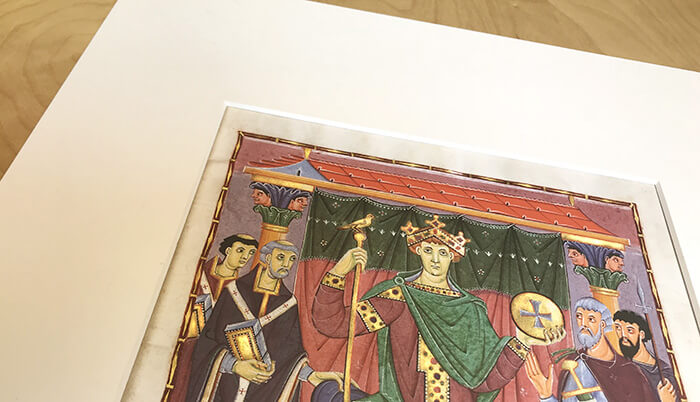
A fine Passe-Partout for each Folio
Each of the original facsimile folios from the Treasures of Reichenau Book Illumination is presented with a bias cut passe-partout. These passe-partouts are made of a special chamois-coloured matt board measuring 44.0 to 33.0 cm. The openings for the individual folios, however, vary according to the size of the original format of the respective manuscripts. After the straight cuts of the matt board have been executed using a semi-automatic cutting plotter, the book binder cuts the edges of the matt board at an angle by hand. Only this traditional craftsmanship will produce accurate results of the desired quality. The function of the passe-partout is to guide the eye, thus helping the viewer to discover every detail of the book illumination.
Treasures of Reichenau Book Illumination
Request brochure
We would be glad to provide you with additional information regarding the fine art facsimile cassette Treasures of Reichenau Book Illumination. Click here to order the brochure.
Contact us
Do you have any questions about the facsimile cassette Treasures of Reichenau Book Illumination? Please do not hesitate to contact us. We are looking forward to your message.




